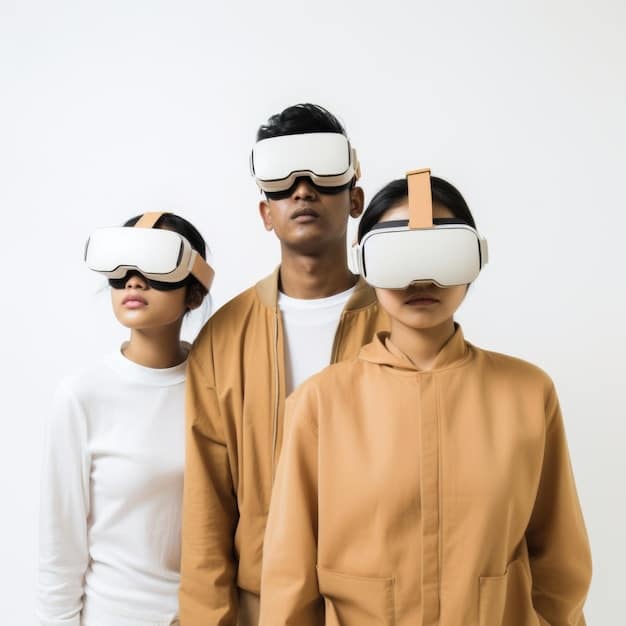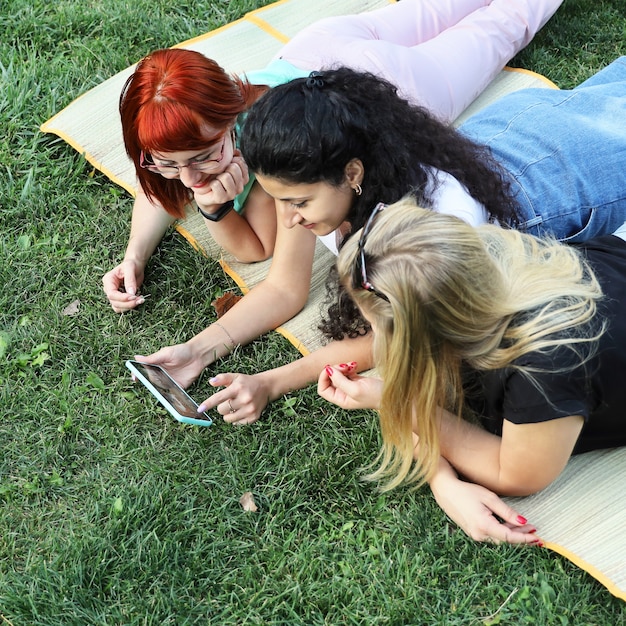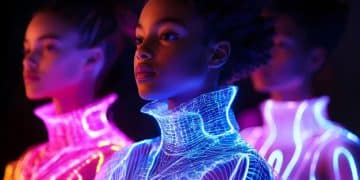XR Revolution: How Gen Z Will Interact by 2025

Extended Reality (XR) is poised to fundamentally reshape Gen Z’s entertainment and social landscape by 2025, blurring the lines between the digital and physical realms and unlocking unprecedented immersive experiences.
Get ready for a revolution! By 2025, the way Gen Z entertains themselves and connects with others will be dramatically altered by Extended Reality (XR). Prepare to step into a world where digital and physical realities merge, creating experiences you never thought possible.
The Rise of XR: What Gen Z Needs to Know
Extended Reality (XR) is an umbrella term encompassing virtual reality (VR), augmented reality (AR), and mixed reality (MR). Understanding the basics of XR is crucial to grasping its potential impact on Gen Z. These technologies are not just futuristic concepts; they are rapidly becoming integrated into everyday life, especially for digital natives.
VR, AR, and MR: Breaking Down the Differences
VR creates fully immersive digital environments, AR overlays digital information onto the real world, and MR blends elements of both. Each technology offers unique possibilities for entertainment and social interaction.
The distinction between these technologies is crucial when considering their applications. VR transports users to entirely different worlds, while AR enhances their existing surroundings.
Why Gen Z is Embracing XR
Gen Z is digitally native, comfortable with new technologies, and actively seeking novel experiences. XR aligns perfectly with their desire for immersive, interactive, and personalized entertainment. This generation has grown up with smartphones and social media, and they are eager to embrace the next evolution in digital interaction.
- Immersive experiences: XR offers a level of engagement unmatched by traditional media.
- Social connection: XR creates new avenues for connecting with friends and like-minded individuals.
- Personalized entertainment: XR experiences can be tailored to individual preferences and interests.
- Novelty and excitement: Gen Z is always looking for the next big thing, and XR delivers.
In conclusion, the rise of XR represents a natural progression for Gen Z, a generation that is comfortable with technology and actively seeks out immersive and engaging experiences. Their willingness to embrace these new technologies will drive innovation and shape the future of entertainment and social interaction.

Gaming and Entertainment: XR’s Immersive Revolution
The gaming and entertainment industries are at the forefront of XR adoption. Gen Z gamers are already experiencing the thrill of VR games, while AR is transforming mobile gaming and location-based entertainment. The immersive nature of XR provides unprecedented opportunities for engagement and realism.
VR Gaming: A New Level of Immersion
VR gaming offers a completely new level of immersion, placing players directly inside the game world. The ability to physically interact with the environment and characters creates a more engaging and realistic experience.
VR arcades and esports tournaments are gaining popularity, attracting Gen Z gamers seeking competitive and social VR experiences.
AR Entertainment: Interactive and Accessible
AR entertainment is more accessible than VR, requiring only a smartphone or tablet. AR games and apps overlay digital content onto the real world, creating interactive and engaging experiences.
Location-based AR experiences, such as AR scavenger hunts and interactive museum tours, are becoming increasingly popular.
The Future of Entertainment with XR
By 2025, XR will have transformed the entertainment landscape, offering a wide range of immersive and interactive experiences. From VR concerts to AR movie theaters, Gen Z will have access to entertainment options that were once only science fiction.
- Virtual concerts: Experience live music in a virtual environment with friends from around the world.
- AR movie theaters: Watch movies in AR, with interactive elements and personalized content.
- Immersive storytelling: Participate in interactive stories that unfold around you in the real world.
In summary, XR’s impact on gaming and entertainment is undeniable. Gen Z is already embracing these technologies, and by 2025, XR will have revolutionized the way they experience entertainment, offering unprecedented levels of immersion, interactivity, and personalization.
Social Interactions: XR Connecting Gen Z Like Never Before
XR is not just about entertainment; it’s also transforming the way Gen Z interacts with each other. Virtual social spaces, AR communication tools, and shared XR experiences are creating new avenues for connection and community. These technologies have the potential to bridge geographical divides and foster deeper relationships.
Virtual Social Spaces: Connecting Across Distances
Virtual social spaces allow Gen Z to connect with friends and like-minded individuals in immersive, digital environments. These platforms offer a sense of presence and shared experience that is often lacking in traditional social media.
Virtual events, such as concerts, conferences, and meetups, are becoming increasingly popular, providing opportunities for connection and collaboration.
AR Communication: Enhancing Real-World Interactions
AR communication tools overlay digital information onto real-world interactions, enhancing communication and collaboration. AR filters, interactive avatars, and real-time translation tools are transforming the way Gen Z connects with each other.

Shared XR Experiences: Building Stronger Bonds
Shared XR experiences, such as collaborative games, virtual travel, and immersive learning, provide opportunities for Gen Z to build stronger bonds and create lasting memories. These experiences foster a sense of shared presence and connection that transcends physical distance.
- Collaborative games: Play games together in a virtual environment, working as a team to achieve common goals.
- Virtual travel: Explore new places and cultures together in a virtual environment.
- Immersive learning: Learn new skills and knowledge together in an engaging and interactive virtual environment.
- XR Therapy and Support Groups: Providing discreet and stigma-free mental health support within virtual environments, making it more accessible for those who might hesitate to seek traditional options.
In conclusion, XR is transforming social interactions for Gen Z, creating new avenues for connection, community, and collaboration. By 2025, XR will have become an integral part of their social lives, bridging geographical divides and fostering deeper relationships.
Education and Training: XR’s Transformative Potential
Beyond entertainment and social interaction, XR has the potential to revolutionize education and training for Gen Z. Immersive learning experiences, virtual simulations, and personalized education programs are creating new opportunities for engagement and knowledge acquisition. This shift can make learning more accessible, engaging, and effective.
Immersive Learning: Engaging and Effective
Immersive learning experiences use VR and AR to create engaging and effective educational environments. Students can explore historical sites, dissect virtual organs, and conduct scientific experiments in a safe and interactive environment.
XR is particularly effective for visual and kinesthetic learners, providing hands-on experiences that reinforce concepts and promote deeper understanding.
Virtual Simulations: Practical Skills Development
Virtual simulations provide opportunities for Gen Z to develop practical skills in a risk-free environment. Medical students can practice surgical procedures, engineers can design and test virtual prototypes, and pilots can simulate flight scenarios.
These simulations offer valuable experience and prepare students for real-world challenges.
Personalized Education: Tailored Learning Paths
XR can be used to create personalized education programs that are tailored to individual learning styles and needs. Adaptive learning platforms can track student progress and adjust the curriculum accordingly, ensuring that each student receives the support they need to succeed.
- Virtual field trips: Explore museums and historical sites from the comfort of your classroom.
- Interactive simulations: Conduct scientific experiments and practice complex procedures in a virtual environment.
- Personalized learning paths: Receive individualized instruction and support based on your learning style and needs.
In summary, XR’s potential to transform education and training for Gen Z is immense. By creating immersive, interactive, and personalized learning experiences, XR can engage students, promote deeper understanding, and prepare them for the challenges of the future.
The Challenges and Opportunities of XR Adoption
While XR offers tremendous potential, there are also challenges to consider. Accessibility, cost, and ethical concerns are all factors that could impact the widespread adoption of XR by Gen Z. Addressing these challenges will be crucial to ensuring that everyone can benefit from this transformative technology.
Accessibility and Affordability: Bridging the Digital Divide
XR headsets and devices can be expensive, creating a barrier to entry for some Gen Z individuals. Ensuring that XR technology is accessible and affordable for everyone is crucial to bridging the digital divide and promoting equitable access to opportunities.
Government subsidies, educational programs, and innovative financing options can help to make XR more accessible to underserved communities.
Ethical Concerns: Privacy, Security, and Well-being
XR raises ethical concerns related to privacy, security, and well-being. Data collection, identity theft, and the potential for addiction are all issues that need to be addressed. Developing ethical guidelines and regulations is essential to protecting Gen Z from harm.
Promoting digital literacy and responsible technology use can help Gen Z to navigate the ethical challenges of XR.
The Future is in the Hands of Gen Z
The widespread adoption of XR depends on addressing these concerns. By overcoming the challenges, the future looks bright for XR and Gen Z. The technology offers incredible educational, social, and entertainment potential.
- Promoting accessibility: Making XR technology affordable and accessible to everyone.
- Addressing ethical concerns: Developing ethical guidelines and regulations to protect users.
- Fostering innovation: Encouraging the development of new and creative XR applications.
In conclusion, the challenges of XR adoption are significant, but the opportunities are even greater. By addressing these challenges and fostering innovation, we can ensure that XR benefits all members of Gen Z, empowering them to learn, connect, and create in new and exciting ways.
The Long-Term Societal Impact of XR on Gen Z
The transformative impact of XR on Gen Z’s entertainment and social interactions will have far-reaching societal implications. From the changing nature of work to the evolution of human relationships, XR is poised to reshape the world in profound ways. Understanding these long-term impacts is crucial to preparing for the future.
The Future of Work: XR-Enabled Collaboration
XR is transforming the way people work, enabling remote collaboration, virtual training, and immersive design. Gen Z will need to develop new skills and adapt to new work environments to thrive in the XR-enabled economy.
XR is creating new job opportunities in areas such as VR/AR development, 3D modeling, and immersive content creation.
The Evolution of Human Relationships: Virtual Communities
XR is creating new avenues for connection and community, but it is also raising questions about the nature of human relationships. As virtual interactions become more prevalent, it is important to maintain a balance between the digital and physical worlds.
XR can be used to strengthen existing relationships and build new connections, but it should not replace face-to-face interaction.
Preparing for The Future
Overall, the long-term societal impact of XR is impossible to predict with certainty. However, several things are clear. It will radically alter entertainment, social interaction, education, and even the way we work.
- Adaptability: Being able to learn new skills and adapt to changing circumstances.
- Digital literacy: Understanding how to use technology safely and responsibly.
- Critical thinking: Evaluating information and making informed decisions.
- The Metaverse Economy: The rise of virtual economies within XR spaces, opening new avenues for digital commerce and entrepreneurship for Gen Z.
In conclusion, XR is poised to have a profound and lasting impact on Gen Z and society as a whole. By understanding these long-term implications and preparing for the future, we can ensure that XR benefits all members of society, creating a more connected, innovative, and equitable world.
| Key Point | Brief Description |
|---|---|
| 🎮 XR Gaming | VR/AR gaming provides immersive, interactive gameplay experiences. |
| 🗣️ Social XR | Virtual spaces allow Gen Z to connect and create communities across distances. |
| 📚 XR Education | Immersive learning and simulations enhance education and skill development. |
| 🌐 Metaverse | XR enables the evolution of the Metaverse, opening new digital commerce and social interaction opportunities for Gen Z. |
FAQ
▼
XR is an umbrella term encompassing technologies like Virtual Reality (VR), Augmented Reality (AR), and Mixed Reality (MR), which blend digital content with the physical world for immersive experiences.
▼
XR will provide more immersive and interactive gaming experiences through VR headsets and AR gameplay on mobile devices, allowing players to step into the game world completely.
▼
XR will bridge distances through virtual social spaces and enhance real-world communication with AR tools, strengthening existing relationships and fostering new connections regardless of location.
▼
Challenges include the high cost of XR devices affecting accessibility, as well as addressing ethical concerns like privacy and security to ensure safe and responsible technology use for Gen Z.
▼
XR provides immersive simulations, interactive learning environments, and personalized education programs, making learning more engaging, effective, and tailored to individual student needs and learning styles.
Conclusion
The integration of Extended Reality into Gen Z’s lives is more than just a technological advancement; it’s a cultural shift. By 2025, XR will likely be a ubiquitous part of how this generation learns, plays, socializes, and even works. While challenges remain in terms of accessibility and ethical considerations, the potential for positive transformation is immense, paving the way for a future where the digital and physical worlds are seamlessly intertwined.





